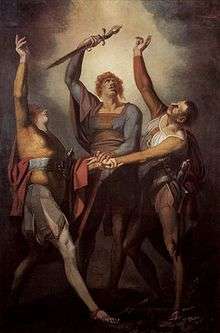Rütlischwur



The Rütlischwur (German pronunciation: [ˈryːtliˌʃvuːr]) is a legendary oath of the Old Swiss Confederacy, taken on the Rütli, a meadow above Lake Lucerne near Seelisberg. The oath is notably featured in the play William Tell (Wilhelm Tell) by Friedrich Schiller.
Early accounts
William Tell is not mentioned in the earliest versions of the Rütlischwur legend.[1] The Rütli oath is first mentioned in the White Book of Sarnen (1470). Its canonical form is that of the 16th century Chronicon Helveticum of Aegidius Tschudi. According to Tschudi, the three oath-takers (Eidgenossen) were Werner Stauffacher for Schwyz, Walter Fürst for Uri and Arnold of Melchtal for Unterwalden.[2]
Early Modern period
The figures of the three oath takers or Eidgenossen during the 16th century merged with the legend of William Tell and became known as "the Three Tells". Impersonations of the Three Tells in historical costume played a role during the Swiss peasant war of 1653.
Historicity
Tschudi dates the event to 8 November 1307.[2] Its historicity is uncorroborated, but also not implausible, the 1307 date falling in a period of a series of similar treaties such as the Federal Charter of 1291, the pact of Brunnen of 1315, the pact of Uri and Urseren of 1317, the pact with Lucerne in 1332, and the Zürich guild revolution of 1336. These were all part of a larger communal movement finally countered by the imperial Golden Bull of 1356 and culminating in the Battle of Sempach of 1386.
Schiller's William Tell (Wilhelm Tell)
In Friedrich Schiller's play William Tell, written in 1804, this oath of the mentioned three men takes place in Walter Fürst's house in Altdorf and basically consists of a promise to meet again on 1 August on the Rütli meadow and to bring with them leading and brave men of the three cantons to decide upon a common action plan. Most notably, among the representatives of Unterwalden was Konrad Baumgarten, a free and wealthy man who killed, in his own residence, the local Habsburg sheriff Wolfenschiessen with an axe in defence of his wife Itta Baumgarten against the sheriff's trespass and inappropriate attempts to approach her. On the other hand, William Tell refused the invitation to come to the Rütli as he was of the opinion that the strong shall act on his own and was skeptical about any common actions.
The most famous version of the oath is no doubt that found in the play:
| German wording | Approximate English translation |
|---|---|
|
Wir wollen sein ein einzig Volk von Brüdern, |
We want to be a single People of brethren, |
Position in Swiss national identity
The building of Switzerland as a federal state in the first half of the 19th century (1803–1848) revived symbols of the period of growth of the Old Swiss Confederacy in the Late Middle Ages, including the legends of William Tell and Arnold Winkelried and the Rütli oath.[3] Patriotic songs such as the Sempacherlied as well as Schiller's play had an important position, and shooting competitions or tirs became an important symbol of the common cause and military readiness of the Confederacy. After the establishment of the federal state, the Rütli oath became associated with the Swiss Federal Charter, a document dated to 1291. This choice was not straightforward, as it went against Tschudi's date of 1307, and historians could enumerate a total of 82 similar documents of the period of 1251 to 1386. The decision was motivated pragmatically, as the modern Swiss capital of Bern was going to celebrate the 700th anniversary of the city's foundation in 1891 and it was convenient to place the 600th anniversary of the Confederacy in the same year. Especially in Central Switzerland, the opportunistic re-dating of the event was resented, and the Rütli oath continued to be dated to 1307 well into the 20th century. Accordingly, the 600th anniversary of the Confederacy was celebrated again in 1907, this time in Altdorf.
It was only after the celebration of the 650th anniversary in 1941, seen as an important symbol of Swiss independence in times of war, that the date of 1291 became universally associated with the Rütli oath. The Swiss national holiday on 1 August marks the date of the Federal Charter (dated to "the beginning of August, 1291), and thus the Rütli oath. Following a public vote on 26 September 1993, 1 August has been an official national holiday since 1994.
The three men who took the oath were the three Landamänner (Canton chiefs) of Uri, Schwyz and Unterwalden; Konrad ab Yberg, Werner von Attinghausen and Konrad Baumgarten. Today only the Ab Yberg family still exists.
See also
- Schwurhand – a traditional three-finger salute which is often depicted in the Rütlischwur
References
- ↑ Ranke, Kurt; Hermann Bausinger; Rolf Wilhelm Brednich (2010). Enzyklopadie Des Marchens: Band 13: Suchen- Verfhrung. Walter de Gruyter. pp. 347–8. Retrieved 2 May 2012.
- 1 2 Foundation traditions in German, French and Italian in the online Historical Dictionary of Switzerland.
- ↑ Heffernan, Valerie (2007). Provocation from the Periphery: Robert Walser Re-examined. Königshausen & Neumann. pp. 45–46.